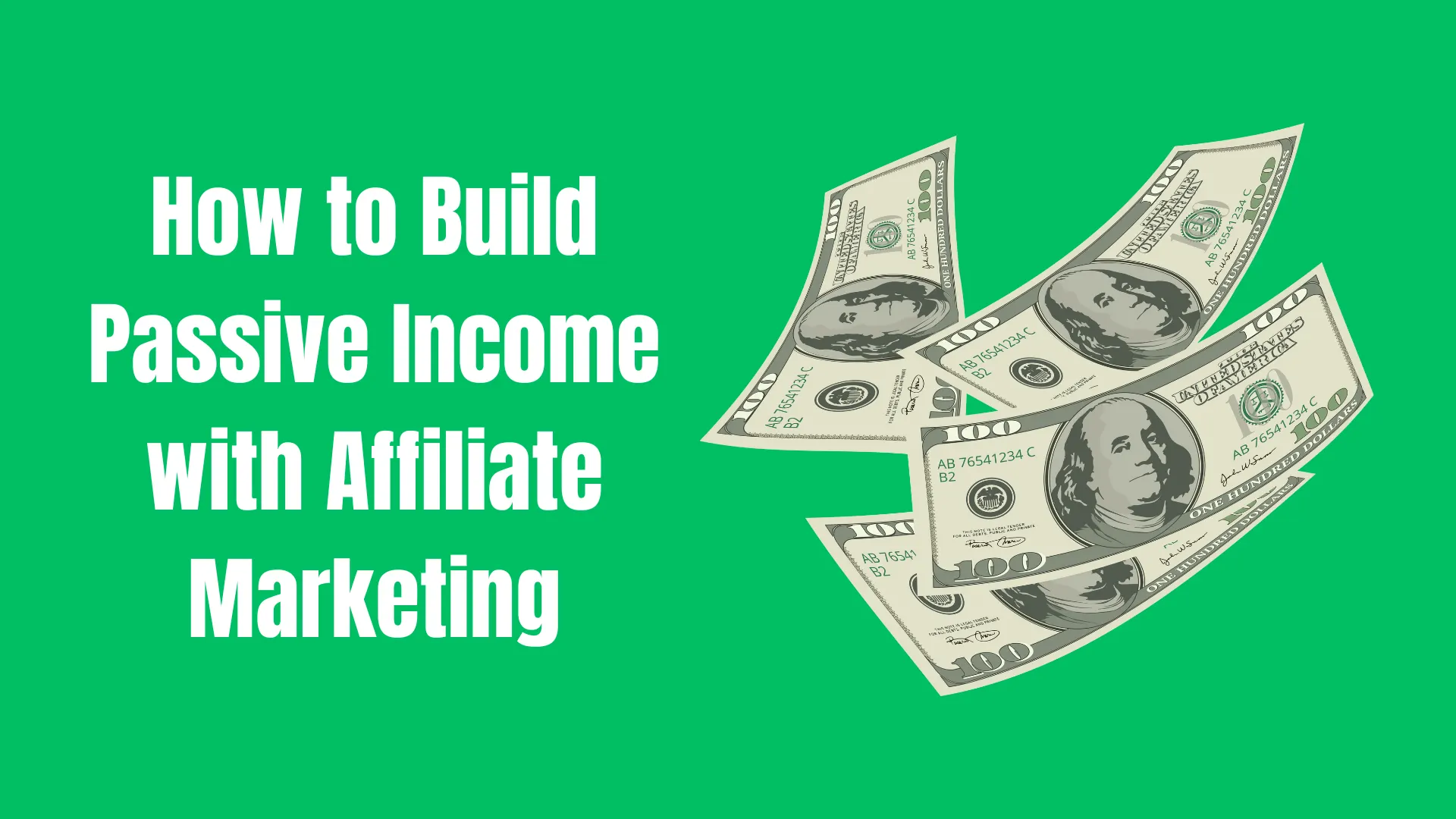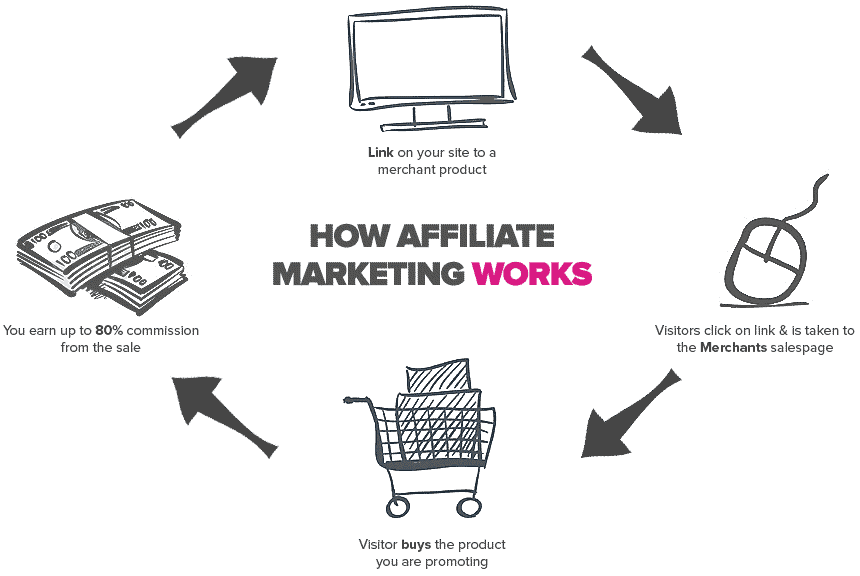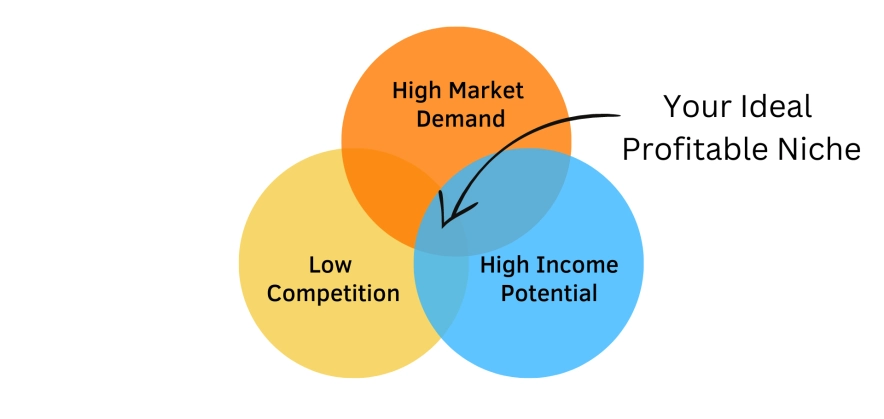How to Build Passive Income with Affiliate Marketing: A Step-by-Step Guide

Making money while you sleep—that’s the dream, right? That’s what passive income is all about. It’s earning without constantly trading time for money. Now, in reality, it’s not truly “passive” at first. You have to put in the work upfront. But once it’s set up, it keeps running with less effort.
Affiliate marketing is one of the best ways to do this. You don’t need to create a product, handle shipping, or deal with customer support. You promote products you trust, earn commissions on sales, and over time, your content does the selling for you. As an experienced marketer, I’ve built a business around this, and I know what works and what doesn’t.
In this guide, am gonna break it down step by step How to Build Passive Income with Affiliate Marketing. No fluff, no gimmicks. Just real strategies to help you start, grow, and scale your affiliate income. Let’s get into it.
Before we continue, I would recommend “Affiliate Marketing Crash Course: The Complete Step-by-Step Guide for Beginners to Generate Passive Income by Selling Other People’s Products“. It’s my favorite guide on this topic.
Key Takeaways
- Passive Income Isn’t Instant – It takes time to build, but once set up, it can generate earnings with little effort.
- Affiliate Marketing is a Top Choice – You don’t need to create products. You earn by promoting others’ products and getting a commission.
- Choose the Right Niche – Pick a topic you understand and that has demand. Avoid niches with little buyer interest.
- Content Drives Sales – Quality content attracts an audience and builds trust. Blogs, videos, and emails all work.
- SEO Matters – Organic traffic is free and long-term. Optimize content to rank on search engines.
- Email Lists Boost Earnings – A strong email list lets you market to the same audience repeatedly.
- Trust is Everything – Promote only products you believe in. People see through fake endorsements.
- Multiple Income Streams Help – Don’t rely on one program. Diversify your affiliate links for better stability.
What Is Affiliate Marketing and How Does It Work?
Affiliate marketing is a simple way to earn passive income by promoting products or services. You join an affiliate program, receive a unique link, and earn a commission when someone buys through it. There’s no need to create a product, handle inventory, or deal with customer service. Here, you just focus on connecting the right audience with the right offer.

Success comes from choosing the right platform and strategy. Whether through blogs, YouTube, social media, or email marketing, the goal is to attract clicks and drive conversions. The more targeted your content, the higher your chances of earning consistent commissions. Some programs offer recurring payouts, turning a single sale into long-term income.
Affiliate marketing rewards effort and smart strategies. Optimizing content, ranking on search engines, and building an email list can grow your earnings over time. With persistence, it becomes a scalable income stream, allowing you to generate revenue while focusing on other opportunities—or simply enjoying life.
Why Affiliate Marketing Is a Great Passive Income Source
Passive income is about making money with minimal ongoing effort. It’s not instant, the hardest part in affiliate marketing is always the start-up but once set up, it can generate income for years. Affiliate marketing stands out as one of the best passive income models. Here’s why.
1. No Product Creation or Maintenance
Selling a product usually means months of research, design, and testing. Then comes inventory management, customer support, and refunds. That’s a full-time job, right?
Affiliate marketing skips all of that. You don’t create, store, or ship anything. You promote someone else’s product, and they handle everything else. Your only job is getting the right audience to the right offer. It’s a simple, low-risk way to earn.
2. Money Works While You Sleep
This sounds too good to be true right? A regular job pays you for hours worked. Stop working, and the money stops. Affiliate marketing flips that. Once you create content—whether it’s a blog post, YouTube video, or email funnel—it keeps working 24/7.
Let’s say you write an in-depth article about the best web hosting services. If it ranks on Google, people will find it day and night. Every time someone clicks your affiliate link and buys, you earn. No extra effort needed.
This is why many affiliate marketers put in heavy work upfront. They know that a well-placed link in evergreen content can make money for years with little to no upkeep.
3. Low Start-Up Costs with High Potential
Starting most businesses costs thousands. You need products, inventory, office space, or at least an initial budget for ads. With affiliate marketing, the barrier to entry is almost nonexistent. I started affiliate marketing with just $34. This was the cost of covering web hosting services.
A simple website and quality content are enough to get started. No need to buy stock or hire employees. You can build a full-time income with just a laptop and Wi-Fi.
Even better, the earning potential is huge. A single blog post or video can generate thousands over time. If you pick the right products—especially high-ticket items or recurring commissions—you can scale up without spending more.
4. Multiple Income Streams for Stability
Relying on one source of income is risky. A job can disappear (you can get fired at your workplace) or your business can go down. A single product can stop selling, but affiliate marketing gives you options.
You can promote different products across various industries. If one program shuts down, you still have others bringing in commissions. Many affiliates diversify even further by using multiple traffic sources which are blogs, social media, email lists, and YouTube.
This flexibility makes affiliate marketing one of the safest passive income streams. Even if a product loses popularity, new ones always emerge.
5. Freedom to Work from Anywhere
Affiliate marketing isn’t tied to an office, a schedule, or even a country. For instance, I personally work from home and I have set up my small office at the corner. As long as you have internet access, you can run your business.
This means no commuting, no boss, and no rigid work hours. Whether you’re working from home, traveling, or just enjoying more personal time, affiliate marketing adapts to your lifestyle.
Of course, it takes effort in the beginning. You need to build content, learn SEO, and find the right audience. But once it’s running, it offers a level of freedom that few income streams can match.
Remember, affiliate marketing isn’t a get-rich-quick scheme (this is where most of the people get it wrong). It takes time, effort, and smart strategy. But once it’s built, it has the power to generate passive income for years with little ongoing work.
If you’re looking for a business model that offers low risk, high flexibility, and unlimited income potential, affiliate marketing is one of the best choices out there.
Steps to Earning Passive Income Through Affiliate Marketing
Affiliate marketing isn’t about making quick money—it’s about building a system that works long-term. The right approach brings steady commissions with less effort over time. But you need a strategy.
Many beginners jump in without a plan and struggle to get results. The key is following a step-by-step process: pick the right niche, join solid affiliate programs, create valuable content, drive traffic, and optimize for conversions. Get these right, and your income grows even while you sleep.
Here’s how to do it the right way.
1. Choose a Niche
Picking the best niche makes or breaks your success. Choose something you understand and enjoy. If you pick a niche just for the money, you’ll burn out fast. Passion matters because affiliate marketing takes time. If you enjoy the topic, creating content will be easier, and you’ll stay motivated.

Look for topics with strong demand and buyers willing to spend. Check search trends, social media engagement, and product demand.
Avoid markets that are too broad or too obscure. For instance, if your niche is digital marketing, narrow it down and go for small sub-niches like affiliate marketing, email marketing social media marketing, and many others. This is what I did and it actually worked best for me.
A niche that’s too competitive makes it hard to stand out. One with little interest won’t get traffic. Find a balance – enough audience interest but not too much competition.
Must Read: How to Choose the Best Niche for Your Affiliate Marketing Business
2. Join Affiliate Programs
Once you have a niche, find affiliate programs that match. Some companies run their own programs, while others use networks like Amazon Associates, ShareASale, or CJ Affiliate. A good program has fair commission rates, reliable tracking, and strong customer support. The last thing you want is to promote a product and not get paid properly.
Don’t sign up for everything, just focus on a few solid programs that align with your content. Too many links can overwhelm your audience and lower conversions. Look for programs with a good commission structure, either recurring commissions or high payouts. Digital products, software, and online courses often pay more than physical products. Choose wisely to maximize earnings.
Must Read: 8 Main Key Features of a Good Affiliate Program
3. Create Content
Content is what brings people to your affiliate links. Blog posts, videos, social media updates—everything should provide value first, then promote the product naturally. Don’t be salesy. People don’t like being sold to, but they do like solutions. Focus on helping, not just selling.
Avoid forcing promotions. Instead, show how the product solves a problem or makes life easier. Reviews, tutorials, and comparisons work well. For example, if you’re promoting a tool, create a guide on how to use it. If it’s a supplement, share your results or research. The goal is to build trust so people feel comfortable buying through your link.
4. Drive Traffic
Good content won’t help if no one sees it. SEO (search engine optimization) helps you rank on Google, bringing free long-term traffic. Research keywords, optimize headlines, and write useful content. Social media can drive quick traffic, but algorithms change often. An email list gives you direct access to your audience and is one of the best ways to boost sales.

Don’t rely on one traffic source. Organic traffic takes time, but it’s free and lasts long. Paid ads can speed things up but require a budget. Social media can drive engagement, but platforms can limit your reach. The best approach is to diversify traffic sources so you don’t depend on one method.
5. Optimize for Conversions
More traffic doesn’t always mean more sales. You need to convert visitors into buyers. Test different CTAs (calls to action), improve page layouts, and make sure your content leads people to take action. If people land on your page but don’t click your links, something needs adjusting.
Track what works and what doesn’t. If a product isn’t converting, try a different one. If a blog post ranks well but doesn’t bring clicks, tweak your links or CTA. Sometimes, changing a button color, rewriting a headline, or repositioning a link can make a big difference. Small changes can lead to more commissions over time.
Affiliate marketing isn’t instant, but with patience and the right approach, it can become a strong source of passive income. Stick with it, keep learning, and keep improving. The effort you put in today can pay off for years.
Tips to Maximize Your Passive Income from Affiliate Marketing
Affiliate marketing works best when you build smart systems that generate income consistently. But many people struggle because they treat it like a side project instead of a real business. Passive income doesn’t mean zero effort—it means setting up a strategy that pays off long-term.
If you want to maximize earnings, you need the right approach. That means picking high-paying programs, creating evergreen content, using SEO, building an email list, and always testing what works. Let’s break it down step by step.
1. Choose High-Paying and Recurring Commission Programs
Not all affiliate programs pay the same. Some offer one-time commissions, while others provide recurring payments. Look for programs that pay well and keep rewarding you over time. Subscription-based services are great for this because you earn every month as long as customers stay subscribed.
Must Read: Understanding the Affiliate Commission Structure: What It Is and How It Works
Also, consider high-ticket affiliate programs. Selling one product that earns you $500 is much easier than selling ten products that earn you $50. The right program can make a huge difference in your long-term income.
2. Create Evergreen Content That Keeps Earning
One-time viral content is nice, but evergreen content is what keeps the money flowing. Focus on articles, videos, and guides that stay relevant for years. From my own experience, product reviews, how-to guides, and comparison posts work well.
For example, instead of writing about a limited-time deal, create a guide on “The Best Web Hosting Services for Bloggers.” This type of content remains useful, attracts traffic over time, and keeps earning commissions long after you publish it.
3. Use SEO to Drive Free, Long-Term Traffic
SEO isn’t optional—it’s a must if you want steady traffic without spending on ads. Ranking on Google means people find your content even while you sleep.
Start with keyword research. Find terms your audience searches for and create content around them. Use free tools like KWFinder to discover long-tail keywords that align with user intent. Optimize your blog posts with proper headings, meta descriptions, and internal links. The better your SEO, the more free traffic you get, which means more potential commissions.
4. Build an Email List for Repeat Sales
Most people don’t buy on the first visit. If you’re not collecting emails, you’re leaving money on the table. A strong email list lets you market to the same people over and over again.
Offer a freebie—like an ebook or a checklist—to encourage sign-ups. Then, send regular emails with valuable content and affiliate recommendations. A loyal email list can generate consistent income, even if your website traffic drops.
Must Read: How to Build a Strong Email List for Your Affiliate Marketing Business
5. Test and Optimize Everything
Affiliate marketing isn’t just about setting things up. It’s about improving what’s already working. Small changes and adjustments can lead to big gains.
Test different CTAs, landing page designs, and email subject lines. Use analytics to see which pages convert best. Double down on what works and cut what doesn’t. The more you optimize, the more you earn.
Finally, remember affiliate marketing isn’t just about promoting links. It’s about building a system that grows over time. Choosing high-paying programs, creating evergreen content, using SEO, building an email list, and optimizing everything makes a huge difference.
It takes time, but if you stick with it, passive income becomes a reality. Keep testing, keep learning, and keep improving. The results are worth it.
Common Mistakes to Avoid in Affiliate Marketing
Affiliate marketing seems simple like ABC…: promote a product, and earn a commission. But many people struggle because they make mistakes that kill their results. Most of these are avoidable, but they can cost you time and money if you’re not careful. Let’s talk about a few of the biggest ones.
Promoting Too Many Products Too Soon
A big mistake is signing up for multiple affiliate programs right away and pushing every product you find. It might seem like more products mean more chances to earn, but the opposite is true.
When you promote too many things at once, your content feels scattered, and your audience won’t trust your recommendations. Instead, start with one or two solid affiliate programs that align with your niche. Learn what works, build trust, and expand only when you have a strong foundation.
Focusing Only on Selling Instead of Helping
People can tell when all you care about is making a sale. If your content feels like a constant sales pitch, visitors will leave. The best affiliate marketers don’t just promote—they educate, help, and solve problems.
Think about what your audience needs. Create content that provides real value first, then introduce your affiliate products naturally. If people trust you, they’ll buy without feeling pressured.
Ignoring SEO and Free Traffic Sources
Many beginners rely only on social media or paid ads to drive traffic. While these can work, they aren’t the best long-term strategy. Paid ads cost money, and social media traffic disappears fast.
SEO is the key to consistent, passive traffic. If you ignore it, you’re missing out on free visitors who are already searching for what you offer. Learn the basics—keyword research, on-page SEO, and link building. Once your content ranks, it keeps bringing in visitors and commissions without extra effort.
Not Tracking and Testing What Works
Some people create content, add affiliate links, and hope for the best. But without tracking your results, you have no idea what’s actually making money.
Use tools like Google Analytics and affiliate dashboards to see where your clicks and sales come from. Test different headlines, CTAs, and content formats. Small changes can double or triple your earnings if you know what’s working.
Affiliate marketing works, but only if you avoid these common mistakes. Start with a focused approach, build trust with your audience, use SEO for free traffic, and track what’s bringing in results. Small improvements can turn a struggling affiliate site into a profitable one. Keep it simple, stay consistent, and don’t give up too soon.
Conclusion
Affiliate marketing is one of the best ways to build passive income, but success doesn’t happen overnight. It takes strategy, patience, and consistent effort.
Many beginners make the mistake of expecting quick results or skipping essential steps like choosing the right niche, creating valuable content, and optimizing for conversions. Those who treat it like a real business, however, see steady growth and lasting profits.
The key is to focus on helping your audience first. Trust drives sales, not just links. Promote products you believe in, write content that answers real questions, and build relationships with your readers. Over time, this approach creates a loyal audience that trusts your recommendations—and that’s where real passive income starts.
Affiliate marketing works, but only if you work it. Learn from your mistakes, test what works, and stay consistent. If you stick with it, the income will follow, giving you more freedom and financial security than any traditional job ever could.
Frequently Asked Questions
How long does it take to make passive income with affiliate marketing?
Affiliate marketing isn’t a quick cash grab. It takes months of consistent effort to build an audience and generate sales. Most beginners see their first commissions within 3-6 months if they create quality content and drive traffic. However, building reliable passive income often takes a year or more. The key is to stay consistent, optimize your strategy, and keep growing your audience.
Do I need a website to succeed in affiliate marketing?
A website isn’t required, but it helps a lot. Having a blog or niche site gives you more control over content, SEO, and audience trust. However, many affiliates make money through YouTube, email marketing, or social media. If you don’t want a website, focus on platforms where you can create valuable content and add affiliate links naturally.
What are the best affiliate programs for beginners?
The best programs depend on your niche, but beginner-friendly options include Amazon Associates, ShareASale, and CJ Affiliate. These platforms offer thousands of products to promote. Digital products and courses, like those on ClickBank or PartnerStack, also pay higher commissions. Always choose programs with good payouts, trusted brands, and reliable tracking.
How do I drive traffic to my affiliate links?
Traffic is the lifeline of affiliate marketing. The best free methods include SEO (writing blog posts that rank on Google), social media marketing, and YouTube videos. Paid ads can work, but they require a budget and testing. Email marketing is another powerful tool—building an email list lets you promote products repeatedly to the same audience.
Can affiliate marketing really become passive income?
Yes, but only if you set it up correctly. Passive income doesn’t mean doing nothing—it means doing the work upfront so you can earn later with less effort. A well-optimized blog, YouTube channel, or email list can generate commissions long after the initial work is done. However, to keep income steady, you must update content, track performance, and adapt to market changes.






